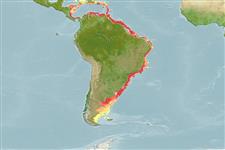Classification / Names
Common names from other countries
Main reference
Size / Weight / Age
Max length : 50.0 cm TL male/unsexed; (Ref. 3702); common length : 35.0 cm TL male/unsexed; (Ref. 3702); max. published weight: 1.0 kg (Ref. 5217)
Length at first maturity
Lm 25.1, range 15 - ? cm
Environment
Marine; brackish; demersal; depth range 1 - 70 m (Ref. 9626), usually 18 - 55 m (Ref. 9626)
Climate / Range
Subtropical, preferred ?; 18°N - 52°S, 83°W - 34°W
Distribution
Short description
Dorsal
spines
(total): 11;
Dorsal
soft rays
(total): 23-27;
Anal
spines: 2;
Anal
soft rays: 9. Colour greyish above, silvery below. Without conspicuous spots, but with faint dark streaks along scale rows above lateral line. Pectoral-fin bases and upper rays slightly dark, pelvic and anal fins often yellowish, dorsal and caudal fins dusky with darker margin. Inside opercle darkish visible externally. Mouth large, oblique, lower jaw slightly projecting. Upper jaw with a pair of large canine-like teeth at tip. Chin without barbel or pores, snout with only 2 marginal pores. Gas bladder with a pair of horn-like anterior appendages. Sagitta (large earstone) moderately broad and thick, Lapillus (small earstone rudimentary. Scales large. Soft portion of dorsal-fin base covered with small scales up to 1/2 of fin height (Ref 51721).
IUCN Red List Status (Ref. 115185)
Threat to humans
Harmless
Human uses
Fisheries: commercial; gamefish: yes
More information
ReferencesAquacultureAquaculture profileStrainsGeneticsAllele frequenciesHeritabilityDiseasesProcessingMass conversion
Tools
Special reports
Download XML
Internet sources
Estimates of some properties based on models
Phylogenetic diversity index
PD50 = 0.5000 many relatives (e.g. carps) 0.5 - 2.0 few relatives (e.g. lungfishes)
Trophic Level
3.8 ±0.66 se; Based on food items.
Resilience
High, minimum population doubling time less than 15 months (Fec = 47,000)
Vulnerability
Low to moderate vulnerability (32 of 100)
Price category
